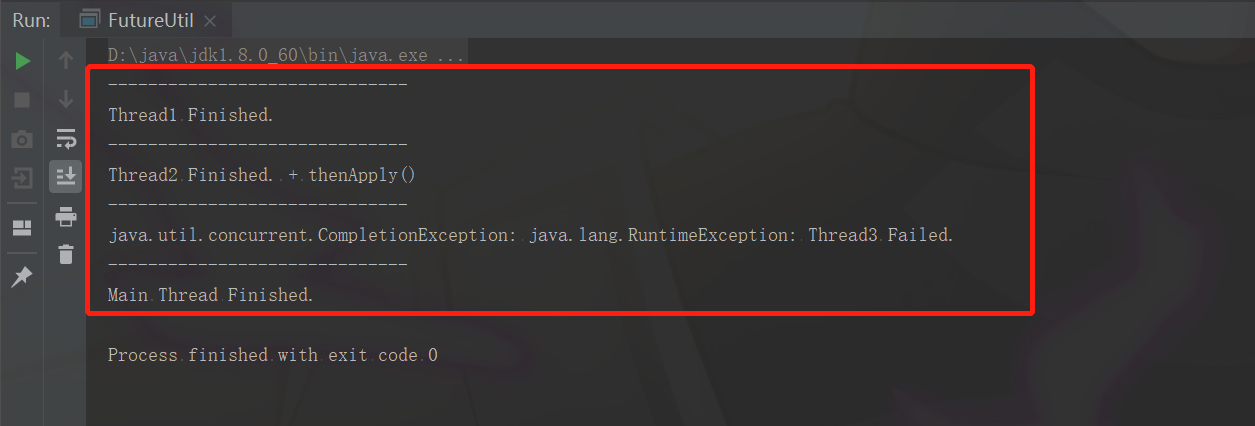CompletableFuture 是 JDK8 提供的一个异步执行工具。
示例1:
public static void main(String[] args) throws ExecutionException, InterruptedException {
CompletableFuture<Void> future = CompletableFuture.runAsync(() -> {
for (int i = 0; i < 3; i++) {
System.out.println(i);
try {
Thread.sleep(1000L);
} catch (InterruptedException ignored) {
}
}
System.out.println("Future Finished.");
});
System.out.println("Main Thread Finished.");
future.get();
}
输出结果1:

CompletableFuture 提供了两个方法用于异步执行:
CompletableFuture.runAsync,没有返回值;CompletableFuture.supplyAsync,有返回值。
示例:
public static void main(String[] args) throws ExecutionException, InterruptedException {
// runAsync 没有返回值
CompletableFuture<Void> future1 = CompletableFuture.runAsync(() -> System.out.println("future1 executed."));
// supplyAsync 有返回值
CompletableFuture<Object> future2 = CompletableFuture.supplyAsync(() -> {
System.out.println("future2 executed.");
return "result";
});
System.out.println("future1.get(): " + future1.get());
System.out.println("future2.get(): " + future2.get());
}
输出结果:

CompletableFuture返回的Future默认为守护线程,如果不调用get()获取结果,主线程结束后会自动结束。主要有以下4种情景:
会执行;不会执行;会执行;会执行。示例:
public static void main(String[] args) {
ExecutorService executorService = Executors.newFixedThreadPool(2);
// 1.执行时间 < 主线程,会打印
CompletableFuture<Void> future1 = CompletableFuture.runAsync(() ->
System.out.println("Thread1 是否为守护线程 : " + Thread.currentThread().isDaemon()));
// 2.执行时间 > 主线程,是守护线程,会被杀死,不会打印
CompletableFuture.runAsync(() -> {
try {
Thread.sleep(3000L);
System.out.println("Thread2 是否为守护线程 : " + Thread.currentThread().isDaemon());
} catch (InterruptedException e) {
e.printStackTrace();
}});
// 3.执行时间 > 主线程,但是不是守护线程,不会被杀死,会打印
CompletableFuture.runAsync(() -> {
try {
Thread.sleep(1000L);
System.out.println("Thread3 等待1秒");
System.out.println("Thread3 是否为守护线程 : " + Thread.currentThread().isDaemon());
} catch (InterruptedException e) {
e.printStackTrace();
}}, executorService);
// 4.ExecutorService.submit(),默认不是守护线程,不会被杀死,会打印。
executorService.submit(() -> {
try {
Thread.sleep(2000L);
System.out.println("Thread4 等待2秒");
System.out.println("Thread4 是否为守护线程 : " + Thread.currentThread().isDaemon());
} catch (InterruptedException e) {
e.printStackTrace();
}});
// 主线程执行完毕
System.out.println("Main Thread Finished.");
executorService.shutdown();
}
输出结果2:

CompletableFuture还封装了很多处理执行结果操作。操作太多,列举比较常用的几种:
thenAccept(): 对结果进行使用;
thenApply(): 对结果进行转换;
exceptionally(): 对异常进行处理;
whenComplete(): 相当于 thenAccept() + thenApply() + exceptionally().

示例:
public static void main(String[] args) {
// thenAccept对结果进行使用
System.out.println("------------------------------");
CompletableFuture.supplyAsync(() -> "Thread1 Finished.").thenAccept(System.out::println);
// thenApply对结果进行转换
System.out.println("------------------------------");
CompletableFuture.supplyAsync(() -> "Thread2 Finished.")
.thenApply(s -> s + " + thenApply()")
.thenAccept(System.out::println);
// exceptionally对异常进行处理
System.out.println("------------------------------");
CompletableFuture.supplyAsync(() -> {throw new RuntimeException("Thread3 Failed.");})
.exceptionally(Throwable::toString).thenAccept(System.out::println);
// 主线程执行完毕
System.out.println("------------------------------");
System.out.println("Main Thread Finished.");
}
输出结果:

whenComplete() 示例:
public static void main(String[] args) throws ExecutionException, InterruptedException {
// thenAccept对结果进行使用
System.out.println("------------------------------");
CompletableFuture<String> future = CompletableFuture.supplyAsync(() -> "Thread1 Finished.").whenComplete(new BiConsumer<String, Throwable>() {
@Override
public void accept(String s, Throwable throwable) {
System.out.println("result: " + s);
System.out.println("throwable: " + throwable);
}
});
// exceptionally对异常进行处理
System.out.println("------------------------------");
CompletableFuture.supplyAsync(() -> {
throw new RuntimeException("Thread3 Failed.");
}).whenComplete(new BiConsumer<Object, Throwable>() {
@Override
public void accept(Object s, Throwable throwable) {
System.out.println("result: " + s);
System.out.println("throwable: " + throwable);
}
});
System.out.println("------------------------------");
System.out.println("future.get(): " + future.get());
// 主线程执行完毕
System.out.println("------------------------------");
System.out.println("Main Thread Finished.");
}
输出结果:

整理完毕,完结撒花~